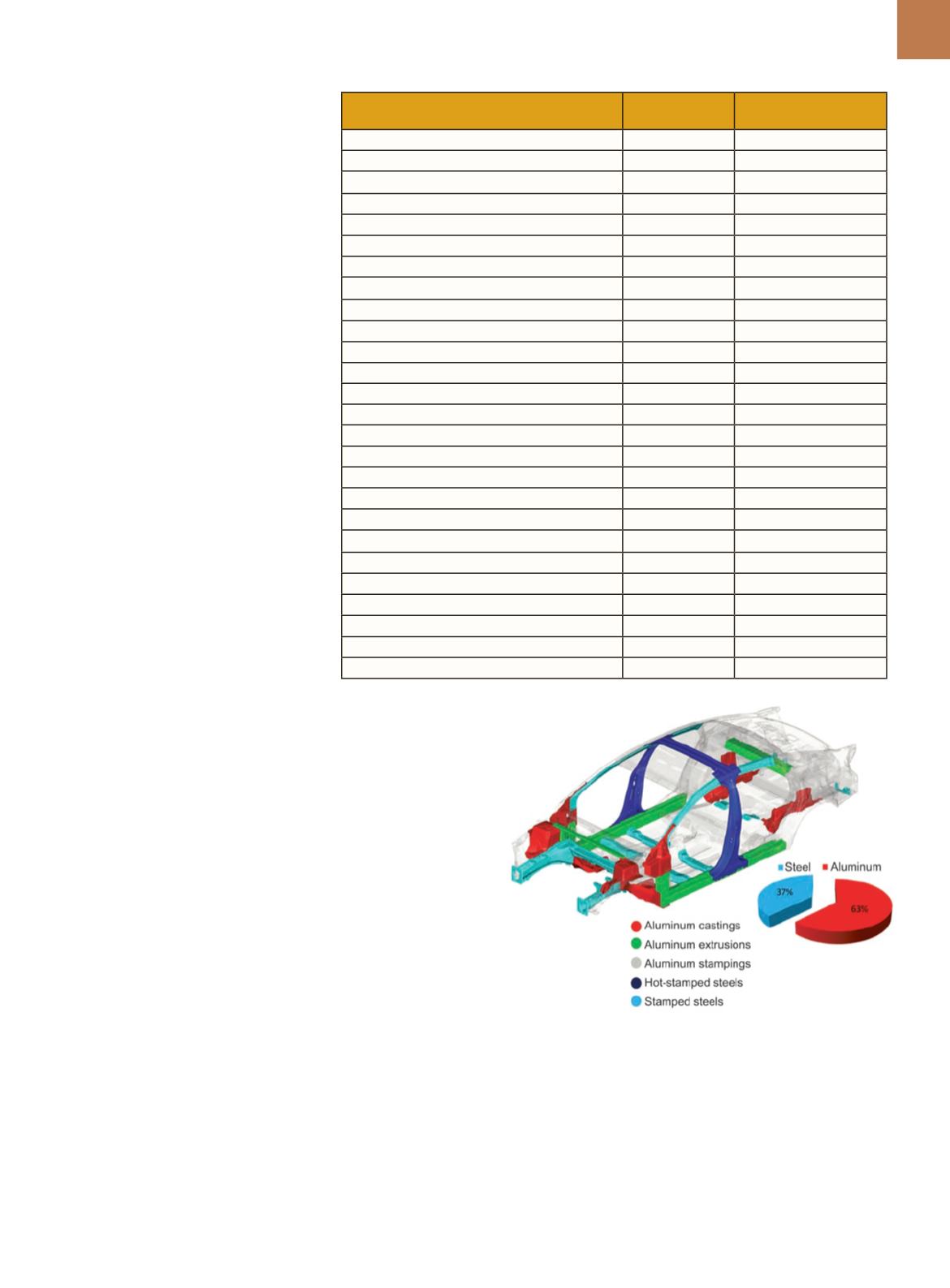

A D V A N C E D
M A T E R I A L S
&
P R O C E S S E S |
M A R C H
2 0 1 5
1 9
A
new multi-material lightweight
vehicle (MMLV) design demon-
strates the potential for light-
weighting of a five-passenger sedan
while maintaining critical vehicle perfor-
mance and occupant safety metrics. The
design incorporates commercially avail-
able materials and production process-
es, achieving a 364 kg (23.5%) full vehicle
mass reduction compared to the 2013 Fu-
sion baseline. In turn, this weight savings
enables use of a 1.0-liter three-cylinder
engine, significantly improving fuel econ-
omy and reducing CO
2
emissions. This
article explores the vehicle design and
material usage details, systemby system.
Over the past 20 years, numerous
studies have investigated the impact of
mass reduction on vehicle fuel efficien-
cy. Generally, a 10% reduction in vehi-
cle mass improves fuel efficiency by ap-
proximately 3-4%. However, whenmass
decompounding is applied, i.e., the op-
portunity to further reduce powertrain
and chassis system weight, a 6-7%
improvement in fuel economy can be
realized while maintaining vehicle per-
formance. The 364 kg weight reduction
from the baseline 2013 Fusion results
from redesigning and lightweighting
five vehicle systems including the body
and closures, interior, chassis, power-
train, and electrical components.
Table 1 describes weight reduc-
tions according to the major systems
within each vehicle subsystem. The
MMLV project allows functional and
drivable vehicles to participate in se-
lected performance tests. Durability,
crash, corrosion, and NVH (noise, vi-
bration, and harshness) tests enable
the design team to ensure that the
weight-reduced vehicle meets specified
requirements.
Magna International led design
efforts on the body-in-white, closures
and bumper structures, subframes and
control arms. Ford designed the power-
train, select chassis components, inte-
riors, electrical, and all other systems.
Referencing the 2013 Fusion, Magna was
responsible for the lightweight design
of components and systems weighing
approximately one-third of the 1559 kg
curb weight. The Ford team was re-
sponsible for the lightweight design
TABLE 1 —MMLV DESIGN WEIGHT DISTRIBUTION BY VEHICLE SUBSYSTEM
Subsystem description, kg
2013 Fusion
MMLV Mach-I
design
Body exterior and closures
594
456
Body-in-white
326
250
Closures-in-white
98
69
Bumpers
37
25
Glazings – fixed and movable glass
37
25
Misc. – trim, mechanisms, paint, seals, etc.
96
87
Body interior and climate control
207
161
Seating
70
42
Instrument panel
22
14
Climate control
27
25
Misc. – trim, restraints, console, etc.
88
80
Chassis
350
253
Front and rear suspension
96
81
Subframes
57
30
Wheels and tires
103
64
Brakes
61
49
Misc. – steering, jack, etc.
33
29
Powertrain
340
267
Engine (dressed)
101
71
Transmission and driveline
106
92
Misc. – fuel, cooling, mounts, etc.
133
104
Electrical
69
59
Wiring
28
25
Battery
14
8
Misc. – alternator, starter, speakers, etc.
27
26
Total vehicle weight
1560
1196
Weight saved compared to 2013 Fusion = 23.3%.
of components and systems weighing
approximately two-thirds of the 2013
Fusion curb weight.
BODY EXTERIOR
AND CLOSURES
The body-in-white
and closures-in-white
account for 424 kg of the 594 kg in
the 2013 Fusion. Magna designed
the body-in-white with all three forms
of aluminum: sheet, extrusion, and
castings. Advanced high-strength steel
sheet was used for the primary safety
structures such as crush rails, b-pillars,
and selected cross car beams. The re-
sulting design weighs 250 kg—a savings
of 76 kg (23%). Figure 1 shows the body
structure with material distribution.
The new MMLV design includes ex-
trudedaluminumbumper andcrushcans
at 11.1 kg (6.2 kg front and 4.9 kg rear)—a
savings of 9.3 kg (46%) from the prior
Fig. 1 —
MMLV design body-in-white mixed
aluminum and steel.
bumper structures. The fascia systems
for the design also include chemically
foamed plastic covers, which shave 2.1 kg
(13%) from the previous fascia systems.
The side doors, fenders, and deck
lid are primarily made of aluminum
with boron steel intrusion beams and


















